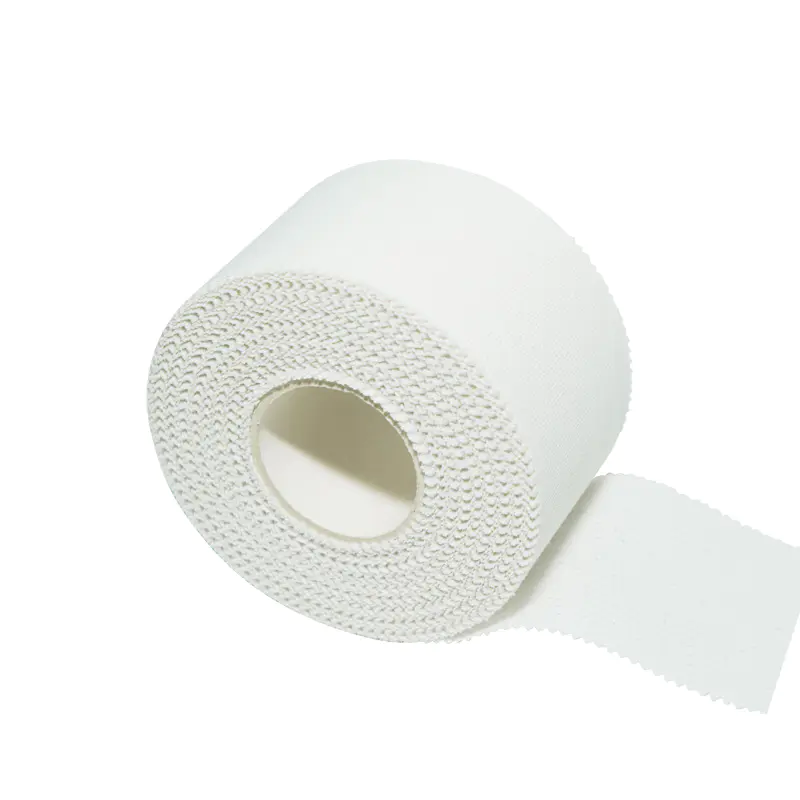Self-adhesive bandages, also commonly known as cohesive bandages or vet wrap (due to their popularity in veterinary medicine), are a type of medical dressing made from a flexible, often elastic, material that has a special coating on one side. This coating allows the bandage to adhere firmly to itself without the need for clips, pins, or tape, making them incredibly convenient and effective for a range of uses.
Support and Compression for Sprains and Strains: One of the most common applications is providing support and light compression for minor sprains and strains in joints like ankles, wrists, and knees. The bandage can be wrapped snugly around the injured area to help reduce swelling and provide stability without restricting circulation excessively.
Securing Dressings and Splints: Self-adhesive bandages are excellent for securing primary wound dressings in place, especially on awkward or moving body parts where adhesive tape might fail. They can also be used to hold small splints or protective pads in position.
Protection for Blisters and Hot Spots: Athletes and hikers often use them to create a protective layer over areas prone to blisters or "hot spots" on the feet, preventing further friction and discomfort.
Post-Surgical Compression: In some cases, they may be used post-surgery for light compression to help manage edema or to keep surgical dressings secure.
Protecting IVs and Catheters: They can be used to stabilize and protect intravenous lines (IVs) and catheters, preventing accidental dislodgement while allowing for flexibility.
No Adhesion to Skin or Hair: This is perhaps their most significant advantage, preventing painful hair pulling upon removal and making them ideal for individuals with sensitive skin or allergies to traditional adhesives.
Flexible and Conforming: Self-adhesive bandages are highly flexible and conform well to the contours of the body, providing even pressure and support without bunching or slipping.
Breathable: Most varieties are designed to be breathable, helping to prevent moisture buildup and skin maceration underneath the bandage.
Easy to Apply and Remove: Their self-adhering nature makes them simple to apply, even one-handed, and they can be easily unwrapped without leaving sticky residue.
Adjustable Compression: Users can control the level of compression applied, allowing for customization based on the injury and comfort level.
Water-Resistant: Many self-adhesive bandages are water-resistant, which helps maintain their integrity even when exposed to moisture.
Self-adhesive bandages are ubiquitous in veterinary practices and for pet owners, often referred to as "vet wrap."
Wound Dressings on Animals: They are indispensable for securing wound dressings on animals, as they do not stick to fur, preventing discomfort and making bandage changes easier.
Support for Animal Injuries: Similar to humans, they provide support for sprains, strains, and other musculoskeletal injuries in pets.
Paw Protection: They are frequently used to protect injured paws or to cover bandages on paws, preventing licking, chewing, and contamination.
Tail Bandaging: Their conforming nature makes them suitable for bandaging tails, which can be challenging with other materials.
Securing Splints and Casts: Vet wrap is often used as an outer layer to secure splints or light casts on animals.
While self-adhesive bandages are incredibly useful, proper application is crucial to avoid complications:
Do Not Apply Too Tightly: Over-tightening can restrict blood flow and cause swelling or nerve damage. Always ensure two fingers can comfortably slide under the edge of the bandage.
Overlap Correctly: Each layer should overlap the previous one by about one-third to one-half to ensure consistent pressure and secure adhesion.
Monitor for Swelling or Discoloration: Regularly check the area distal to the bandage for signs of compromised circulation, such as coolness, pallor, numbness, tingling, or increased pain.
Change When Soiled or Wet: To prevent skin irritation or infection, replace the bandage if it becomes dirty, wet, or loses its integrity.
In conclusion, self-adhesive bandages are an indispensable tool for both human and animal care, offering a convenient, effective, and patient-friendly solution for support, compression, and dressing retention. Their unique design makes them a go-to choice for a wide array of first-aid and medical needs.








